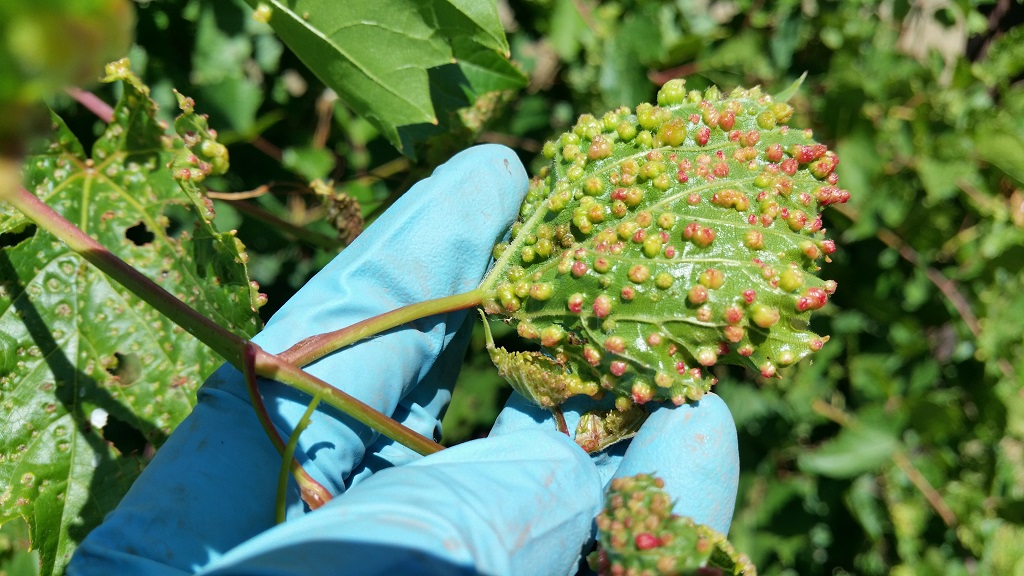Image: Leaf galls induced by phylloxera. Credit: Agriculture Victoria
An Agriculture Victoria research project studying phylloxera has revealed new ways to improve detection and management of the destructive grapevine pest.
Over the past three years, a $1.5 million project co-funded with Wine Australia has delivered a new portable technology for rapid identification of phylloxera in the field, new knowledge in assisting screening of rootstock resistance, and new disinfestation practices to help prevent the pest from spreading.
“Phylloxera are tiny insects about a millimetre long and are extremely difficult to identify even with the trained eye of an expert,” said Agriculture Victoria’s lead insect diagnostician Dr Mark Blacket.
“We’ve developed a portable assay that gives rapid and accurate molecular identification of a suspect phylloxera in less than an hour – before now the process of identification could take up to a week.”
The assay is called LAMP (loop-mediated isothermal amplification) and can be carried out under field conditions using a portable device (a LAMP machine) that is about the size of a laptop.
“LAMP provides a simple method to confirm the identity of the pest in a vineyard and will save valuable time in decision making for biosecurity officers,” said Dr Blacket.
“We’ve shown it works with insects removed directly from roots, and on phylloxera obtained from traps placed underneath the vines.”
In addition to developing the new LAMP tool for DNA identification of phylloxera, the project team has also made a new discovery about the genetic diversity of the insects in Australia.
Their study collected phylloxera from across the King Valley wine region in Victoria, where the genetic diversity of the pest was first studied in early 2000.
Having carried out genetic studies, the team compared findings with a former study conducted 30 years ago. The new study identified 32 new strains of phylloxera.
“Genetic differences among phylloxera underlies the ability of certain strains to overcome resistance in rootstock cultivars,” said Agriculture Victoria phylloxera research lead Dr Catherine Clarke.
“By knowing more about these genetically different strains and how they spread, we can provide better advice to growers about which rootstocks might be most suitable against phylloxera in their locality.”
Wine Australia general manager – research, development and adoption Dr Liz Waters said the King Valley study indicates that changes in genetic variability of phylloxera could threaten the long-term stability of rootstock tolerance to the pest.
“The identification of new strains presents a number of challenges as each strain of phylloxera has the possibility of a different impact, particularly on tolerant and resistant rootstocks,” said Dr Waters.
“Due to the critical need for accurate rootstock data, the project also expanded the rootstock testing program which delivered new information on the resistance status of particular rootstocks to certain phylloxera strains.
“The rootstock 5C Teleki was screened against a panel of phylloxera strains, and a range of rootstocks were tested for resistance to the virulent strain G38, in the field and under controlled conditions.
“This new information will be fed into the Grapevine Rootstock Selector tool for easy referral.”
For producers within phylloxera-infested zones, farmgate hygiene and disinfestation are vitally important in stopping the spread and inadvertently introducing a new strain to vineyards.
In studying disinfestation practices to limit the spread of phylloxera, the project has identified a product available from supermarkets that is effective for disinfestation of footwear and hand-held tools.
“Preventative biosecurity practices are the best form of defence,” Dr Clarke said.
“Current best practice suggests bleach is optimal for disinfestation of footwear and hand tools, to prevent phylloxera from travelling within and outside quarantine zones.
“However, it is not favoured by growers due to the hazards posed by chlorine odours and residues, and the damage it causes to footwear and tools.
“We found that Dettol, a readily available disinfectant, is a suitable substitute for bleach. It’s adding to the arsenal of tools that growers can use at the farm gate.”
Phylloxera is a hardy insect pest, but the research found Australian strains in general are sensitive to temperatures above 30ºC and below 18ºC.
It was also found that fermentation for 48 hours is sufficient to kill phylloxera in ferments with commercial yeast added, but not necessarily for ‘wild’ ferments. Further research will firm up these results and determine how fermentation can be applied to disinfest grape products during winemaking.
A new research project co-funded by Agriculture Victoria and Wine Australia will build on the project’s findings to further improve the nation’s strategy to control phylloxera through more effective disinfestation procedures, validating the LAMP DNA surveillance tool for use in field detection, improving selection of resistant grapevine rootstocks, and looking at native biological control options, such as Australian plants and native insects.
“Phylloxera remains a challenge for the Australian wine sector,” Dr Clarke said.
“But it’s a challenge that we’re continuing to build solutions to address and provide support to ensure the sector can manage.”
The final report for the project Integrated management of established grapevine phylloxera is available on Wine Australia’s website.
Are you a Daily Wine News subscriber? If not, click here to join our mailing list. It’s free!
















